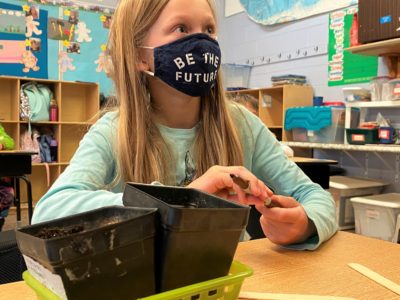

|
|
Innovation has been embraced by most sectors of our society and it is reassuring that interest in innovation in education is also starting to grow. Although we often recognize innovation when we see it, educators and policymakers need more guidance if innovation is to play a bigger role in educational improvement.
However, seeking a definition or list of agreed-upon characteristics as to what constitutes educational innovation might seem to go against the very idea of innovation. Innovation occurs in specific contexts with specific people and in response to unique problems.
It may not be surprising, therefore, that there is no one definition of educational innovation. In fact, the Canopy Project, a nonprofit collecting innovative practices across the country, lists 92 tabs, each one describing a separate innovative practice. On the other hand, given that many of the problems of practice are the same across schools, there are some common themes to educational innovation. Being able to describe these common themes may help provide some clarity to this important term.
The one theme common to nearly all definitions of educational innovation is the move to make education more student- or learner-centered. This is also referred to as “personalizing education” and can include discovering individual students’ talents.
Four national organizations advocate for educational innovation: Canopy Project/Transcend/Christensen Institute, Teacher Powered Schools, Education Reimagined, and Innovative Schools Network. What do these four organizations understand by educational innovation? First, while all four organizations support innovation, it is important to recognize that they all have a slightly different focus:
| Organization | Goals/Purpose |
| Canopy Project/Transcend/Christensen Institute | To build collective knowledge on a more diverse set of innovative schools across the country. |
| Teacher Powered Schools | To prepare students for a 21st century world, and equitably honor the potential in all students, which requires rethinking the design of learning to include students at the center. |
| Education Reimagined | To transform the current education system which has proven itself inequitable, inflexible, and inadequate. To powerfully serve, include, value, and love every single child. |
| Innovative Schools Network | To support the establishment and growth of high quality, research-based innovative schools by providing professional training and guidance, and ensuring that educators can easily collaborate, connect, and learn from one another. |
A database of innovative traits
Instead of advocating for a specific definition, the Canopy Project is interested in recording the diversity of innovative characteristics as identified by school leaders.
The organization, which began in 2019, has the goal of building collective knowledge on a more diverse set of innovative schools across the country. There is a two-step process for identifying schools. First, nominating organizations from across the country identify schools to be included in the Canopy. (See this article on North Carolina’s Canopy Schools.)
Second, school leaders identify their school’s innovative practices using a “tagging system” — a set of keywords describing innovative designs. The Canopy Project distinguishes between tags that are broad approaches, like social-emotional learning, and narrower design decisions like student-led conferences or makerspace.
Recently, the Canopy Project added a new step in which schools are asked to identify up to five practices that they see as core to their school’s models. School leaders are also asked to indicate how long each core practice has been implemented.
A December 2020 blog from the organization says the tag that school leaders cited most often as being core to their school models was project-based learning. Social-emotional learning, was the second-most cited core practice. Over 60% of schools with PBL as a core practice report implementing it for five years or more.
Different strategies and definitions
Education Evolving is a nonprofit, nonpartisan organization driving transformational designs for learning, larger professional roles for teachers, and policy environments that enable and encourage innovation. They describe the importance of equitably honoring the potential in all students and rethinking the design of learning to have students placed at the center.
They state, learning “must be built on a foundation of strong relationships, responsive to basic needs, driven by student interests, respectful of their identities, adaptive to their academic needs, relevant to their lives beyond school, and not confined within school days and walls.”
Achieving this requires 1) that teachers have larger professional roles in designing and leading schools and 2) that policy is changed to enable and support innovation by creating space, removing barriers, and creating a climate of encouragement. The organization says that over time the system changes organically, as innovative approaches to learning are tried, refined, replicated, and adopted by others.
Education Reimagined is committed to transforming education, to powerfully serve, include, value, and love every single child. Justice, inclusion, and equity are central to enabling all children to fulfill their full potential as empowered individuals. The organization supports a learner-centered paradigm including personalized learning that is competency-based and has a wide range of learning environments and adult roles.
Learning occurs for students through self-directed discovery with their peers and with the guidance of adults. Learning happens at many times and in many places, and “all learning experiences, whether highly structured or exploratory and experiential, are valued, encouraged, and integrated into the learner’s journey.”
The Innovative Schools Network identifies seven broad areas of educational practice — pedagogy, curriculum, assessment, school design, governance, scheduling, and relationships — and under each area provides examples of innovative practices. For example, under pedagogy, there are ten practices including project-based learning, inquiry, and experiential learning.
The overlapping themes
In addition to being student-centered, the following common themes emerge from a comparison of these four organizations:
- Learning is connected to student’s interests and focuses on solving real world problems.
- Interdisciplinary.
- Anytime, anywhere.
- Learning involves the whole child — social, emotional, and academic.
- Priority is given to equity in student learning and discipline.
- Students demonstrate learning through competency rather than seat time.
- Meaningful assessment of learning through portfolios and public exhibitions.
- Community and business partnerships.
When it comes to teachers and school organization, common characteristics across approaches were:
- Design-thinking culture.
- Creative governance and staffing.
Educational innovation is an important concept that can offer a new direction for school improvement in North Carolina.





